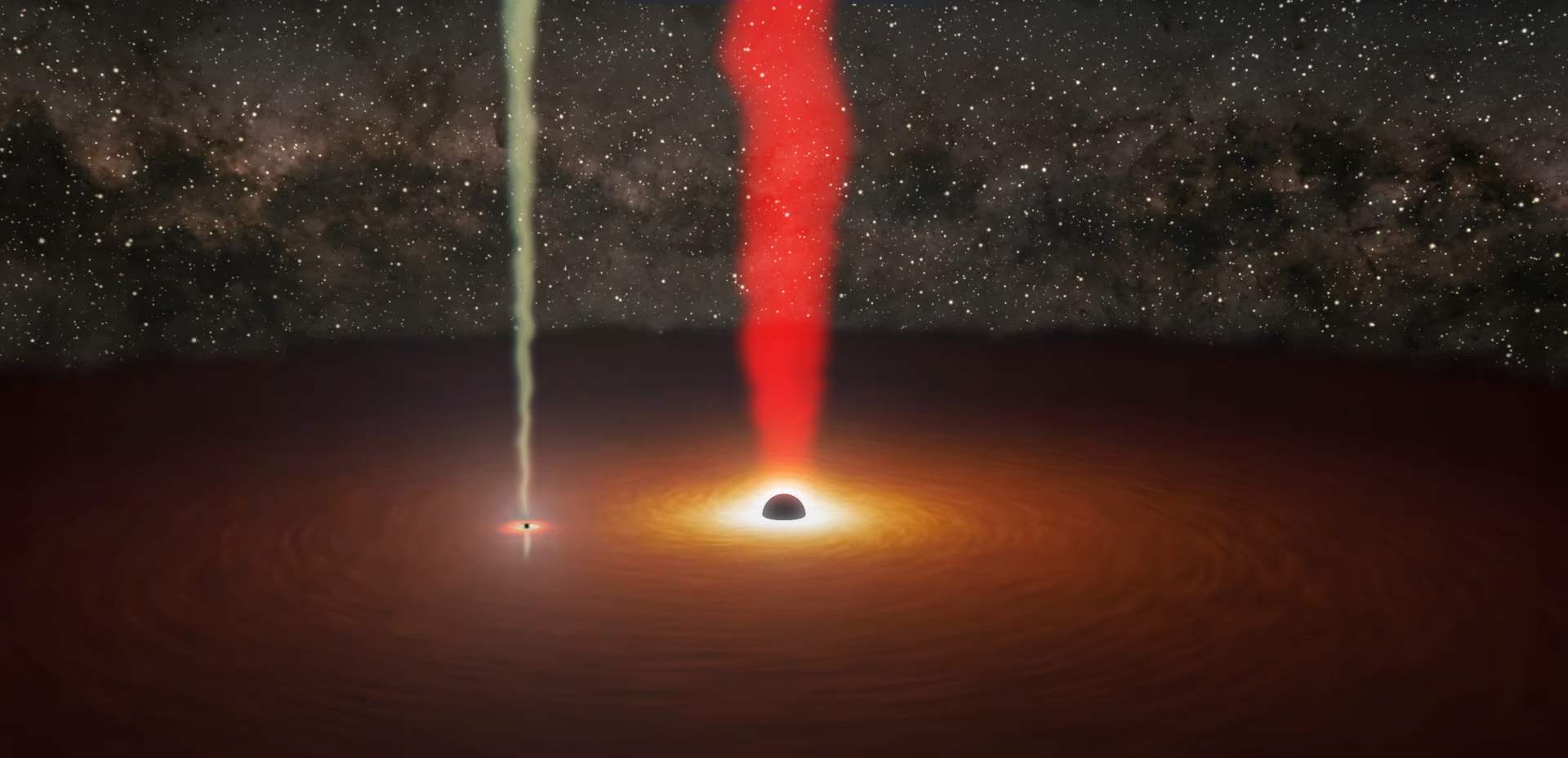Several international research groups have confirmed the theory, first proposed by astronomers at the University of Turku in Finland, that two black holes reside at the center of the distant galaxy OJ 287. Using the Transiting Exoplanet Survey Satellite (TESS), researchers observed the brightness of the main black hole and its associated jet, thereby confirming the presence of the smaller black hole. The findings have been published in The Astrophysical Journal.
 The black holes in orbit around each other. Both black holes have jets associated with them: the larger one with a reddish color, and the smaller one with a yellowish color jet. Normally only the reddish jet is seen, but during the 12 hours on November 12, 2021, the smaller jet dominated, and gave a direct signal from the smaller black hole, and was observed for the first time. Image Credit: NASA/JPL-Caltech/R. Hurt (IPAC) and M. Mugrauer (AIU Jena).
The black holes in orbit around each other. Both black holes have jets associated with them: the larger one with a reddish color, and the smaller one with a yellowish color jet. Normally only the reddish jet is seen, but during the 12 hours on November 12, 2021, the smaller jet dominated, and gave a direct signal from the smaller black hole, and was observed for the first time. Image Credit: NASA/JPL-Caltech/R. Hurt (IPAC) and M. Mugrauer (AIU Jena).
In 2021, NASA's exoplanet-hunting satellite, TESS, was directed towards the galaxy OJ 287 to assist astronomers in verifying the presence of two black holes at the galaxy's center—a theory first proposed by researchers at the University of Turku, Finland.
The Transiting Exoplanet Survey Satellite (TESS) primarily aims to discover thousands of exoplanets orbiting the brightest dwarf stars in the sky. TESS has already confirmed 410 exoplanets, or “new worlds,” orbiting stars other than the Sun, showcasing the diversity of planetary systems in the Milky Way galaxy.
For several weeks in 2021, TESS studied OJ 287, a distant galaxy, providing indirect evidence that a massive black hole, 100 times larger than another, is orbiting a giant black hole. Researchers observed the brightness of the main black hole and its associated jet to confirm the presence of the smaller black hole.
Although direct observation of the smaller black hole orbiting the larger one is extremely challenging, the researchers detected its presence due to an abrupt burst of brightness. This event, predicted by Pauli Pihajoki of the University of Turku in a 2014 doctoral dissertation, was unprecedented in OJ 287. The dissertation anticipated a flare in late 2021, prompting multiple satellites and telescopes to focus on the object.
On November 12, 2021, at 2 am GMT, TESS observed the anticipated flare. Shubham Kishore, Alok Gupta, and Paul Wiita from The College of New Jersey, USA, recently published these observations. The event, lasting only 12 hours, underscored the difficulty of detecting a significant burst of brightness without prior knowledge of its timing. The Turku researchers' theory proved accurate, and TESS was optimally aimed at OJ 287. NASA’s Swift telescope, also targeting the same object, corroborated the discovery.
A large international collaboration led by Staszek Zola from Jagiellonian University in Cracow, Poland, utilized telescopes worldwide to detect the same event, ensuring continuous nighttime observation. A team from Boston University, led by Svetlana Jorstad, validated the finding by examining the polarization of light before and after the flare.
Professor Mauri Valtonen and the research team at the University of Turku combined all previous observations into a single study, demonstrating that the 12-hour burst of light originated from the smaller black hole in orbit and its surroundings.
When the smaller black hole swallows a significant portion of the accretion disk surrounding the larger black hole, it creates an outward-facing jet of gas, causing a sudden burst of brightness. For approximately 12 hours, the jet from the smaller black hole becomes brighter than that of the larger black hole, causing OJ 287 to appear less reddish and shift towards yellow. After the explosion, the red color reappears. The yellow color indicates that during this period, light from the smaller black hole is visible to astronomers. Other characteristics of the light emitted from OJ 287 during this time support these conclusions.
Professor Valtonen said, “Therefore, we can now say that we have ‘seen’ an orbiting black hole for the first time, in the same way that we can say that TESS has seen planets orbiting other stars. And just as with planets, it is extremely difficult to get a direct image of the smaller black hole. In fact, because of OJ 287's great distance, which is close to four billion light years, it will probably take a very long time before our observation methods have developed enough to catch a picture even of the larger black hole.”
However, the smaller black hole may soon reveal its existence in other ways, as it is expected to emit nano-Hertz gravitational waves. The gravitational waves of OJ 287 should be detectable in the coming years by the maturing pulsar timing arrays.
A. Gopakumar, Tata Institute of Fundamental Research
Journal Reference:
Valtonen, J., M., et al. (2024) Evidence of Jet Activity from the Secondary Black Hole in the OJ 287 Binary System. The Astrophysical Journal. doi/org/10.3847/2041-8213/ad4d9b
Kishore, S., et al. (2023) Rapid Optical Flares in the Blazar OJ 287 on Intraday Timescales with TESS. The Astrophysical Journal. doi/org/10.3847/1538-4357/ad0b80